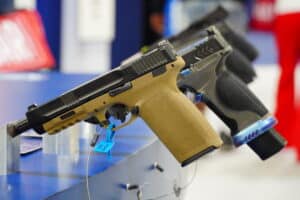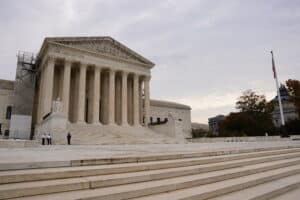The federal government can’t bar a Pennsylvania man from owning guns for life over his food stamp fraud conviction.
That’s the ruling handed down by a full panel of the Third Circuit Court of Appeals on Tuesday. The court found no historical basis for banning Bryan Range from buying firearms over a conviction for lying on a food stamp application in 1995. It also found he is included among those protected by the Second Amendment and concluded it is unconstitutional to block him from having guns, reversing a 2022 ruling by a three-judge panel from the same court.
“We agree with Range that, despite his false statement conviction, he remains among ‘the people’ protected by the Second Amendment,” Judge Thomas Hardiman, a George W. Bush appointee, wrote for an 11-4 majority that included two Biden, an Obama, and a Clinton appointee in Range v. AG. “And because the Government did not carry its burden of showing that our Nation’s history and tradition of firearm regulation support disarming Range, we will reverse and remand.”
The ruling applies specifically to Ryang but calls into question the constitutionality of the gun ban for all non-violent felons, though it only applies to Range specifically and sets a precedent for cases in the Third Circuit–which includes Pennsylvania, New Jersey, Delaware, and the Virgin Islands. It is the latest federal appeals court ruling that upends the status quo for federal gun regulations in the wake of the Supreme Court’s 2022 ruling in New York State Rifle and Pistol Association v. Bruen. That ruling set a new standard for judging gun laws based on whether they correspond with restrictions from the founding era and has called into question gun bans for those subject to domestic violence restraining orders, drug users, adults under 21, and more.
Range’s ordeal stems from a time when he lied on an application for food stamps nearly thirty years ago. Range’s wife prepared an application that understated his income, which he signed. He pled guilty to a state misdemeanor and was sentenced to three years probation. He paid under $3,000 in fines and restitution.
Despite never serving a day in jail, Range was barred from owning guns under federal law. That’s because federal law prohibits anyone convicted of a felony that could be punished with more than a year in prison or a misdemeanor punishable by more than two years in prison from possessing guns. Range’s crime could have been punished by up to five years in prison.
The Third Circuit concluded his crime, being both non-violent and not involving the use of a firearm, would not have historically resulted in a lifetime ban on gun possession.
“The Government has not cited a single statute or case that precludes a convict who has served his sentence from purchasing the same type of object that he used to commit a crime,” Judge Hardiman wrote. “Nor has the Government cited forfeiture cases in which the convict was prevented from regaining his possessions, including firearms (except where forfeiture preceded execution). That’s true whether the object forfeited to the government was a firearm used to hunt out of season, a car used to transport cocaine, or a mobile home used as a methamphetamine lab. And of those three, only firearms are mentioned in the Bill of Rights.”
The majority rejected the argument that Range could be prohibited from owning guns because governments during the founding era passed bigoted bans on Blacks or Native Americans owning guns.
“Apart from the fact that those restrictions based on race and religion now would be unconstitutional under the First and Fourteenth Amendments, the Government does not successfully analogize those groups to Range and his individual circumstances,” the court wrote. “That Founding-era governments disarmed groups they distrusted like Loyalists, Native Americans, Quakers, Catholics, and Blacks does nothing to prove that Range is part of a similar group today. And any such analogy would be ‘far too broad.'”
Similarly, the majority ruled Range couldn’t be excluded from the protections of the Second Amendment because of his relatively-minor criminal record. They argued he was still among those considered “the people” and would not be precluded from protections provided by other parts of the Bill of Rights due to the food stamp conviction.
“[O]ther Constitutional provisions reference ‘the people,'” Judge Hardiman wrote. “It mentions ‘the people’ twice with respect to voting for Congress, and ‘the people’ are recognized as having rights to assemble peaceably, to petition the government for redress, and to be protected against unreasonable searches and seizures. Unless the meaning of the phrase ‘the people’ varies from provision to provision—and the Supreme Court in Heller suggested it does not—to conclude that Range is not among ‘the people’ for Second Amendment purposes would exclude him from those rights as well. And we see no reason to adopt an inconsistent reading of ‘the people.'”
Additionally, the majority said the fact that some non-violent convicts were executed during the founding era has no bearing on whether Range’s punishment is constitutional.
“That Founding-era governments punished some nonviolent crimes with death does not suggest that the particular (and distinct) punishment at issue—lifetime disarmament—is rooted in our Nation’s history and tradition,” the court wrote. “The greater does not necessarily include the lesser: founding-era governments’ execution of some individuals convicted of certain offenses does not mean the State, then or now, could constitutionally strip a felon of his right to possess arms if he was not executed.”
Still, they argued the decision “is a narrow one” that is specific to Range and his individual circumstance.
“Bryan Range challenged the constitutionality of 18 U.S.C. § 922(g)(1) only as applied to him given his violation of 62 Pa. Stat. Ann. § 481(a),” Judge Hardiman wrote for the majority. “Range remains one of ‘the people’ protected by the Second Amendment, and his eligibility to lawfully purchase a rifle and a shotgun is protected by his right to keep and bear arms. Because the Government has not shown that our Republic has a longstanding history and tradition of depriving people like Range of their firearms, § 922(g)(1) cannot constitutionally strip him of his Second Amendment rights.”
Thomas Lee Ambro, a Clinton appointee, emphasized that point in his concurrence.
“That Range does not conceivably pose such a threat says nothing about those who do,” he wrote. “And I join the majority opinion with the understanding that it speaks only to his situation, and not to those of murderers, thieves, sex offenders, domestic abusers, and the like.”
The dissenters were not convinced, though. They argued the logic employed by the court could be extended well beyond Range’s circumstances.
“[T]he Majority’s analytical framework leads to only one conclusion: there will be no, or virtually no, felony or felony-equivalent crime that will bar an individual from possessing a firearm,” Patty Shwartz, an Obama appointee, wrote for herself and L. Felipe Restrepo, a Biden appointee. “This is a broad ruling and, to me, is contrary to both the sentiments of the Supreme Court and our history.”
Cheryl Ann Krause, an Obama appointee, went even further and suggested the ruling would cause chaos.
“Our district courts are left without any intelligible standard, and our citizenry will be left reeling from the consequences: a flood of motions to dismiss indictments, appeals, and reversals of § 922(g)(1) convictions; more armed felons and gun violence on our streets; less faith in elected representatives stymied in their efforts to protect the public; and less trust in a judiciary mired in formalism and the usurpation of legislative function,” she wrote.
She also attacked the majority’s historical analysis and argued it was out of line with what the Supreme Court had established in its landmark Second Amendment rulings.
“In Bruen, the majority characterized the holders of Second Amendment rights as ‘law-abiding’ citizens fourteen times. Delimiting the ‘unqualified command’ of the Second Amendment to ‘law-abiding’ individuals was not novel,” Judge Krause wrote. “In holding ‘the right of the people’ protected by the Second Amendment was an ‘individual right,’ Justice Scalia’s seminal opinion in Heller specified this meant ‘the right of law-abiding, responsible citizens’ to keep and bear arms, and therefore characterized ‘prohibitions on the possession of firearms by felons’ as both ‘longstanding’ and ‘presumptively lawful.'”
Ultimately, she chided the High Court to weigh in on the case.
“The sooner the Supreme Court takes up this issue, the safer our republic will be,” she said.
Judge Ambro agreed with the call for further insight from the Supreme Court.
“I close with the observation that the Supreme Court will have to square its history-driven test with its concurrent view that felon gun restrictions are presumptively lawful,” he wrote.
He argued the majority opinion and his concurrence offer a meaningful justification for the continued prohibition against most felons owning guns that the Supreme Court should agree with because striking down the whole ban would be detrimental even beyond the question of gun crime.
“This opinion is one attempt to offer a historical justification for § 922(g)(1), recognizing that history offers,” Judge Ambro wrote. “And if that proves unsatisfying to the Court, it may do away with the presumption that disarming felons is lawful. I hope it does not do so. Not just because arming those who pose a threat to the orderly functioning of society will lead to more deaths, but because it would be a dangerous precedent. It is incongruous to believe history displaces means-ends balancing for the Second Amendment only. The Court’s approach here will affect our ability to pass any rights-burdening law—whether the right be protected by the First, Second, Fourth, or Sixth Amendment—that lacks a neat historical basis. I trust it will fulfill its promise that Bruen imposes no ‘regulatory straightjacket,’ and permit § 922(g)(1) to apply to those who threaten the orderly functioning of civil society.”
The Department of Justice did not respond to a request for comment.
UPDATE 8:05 PM EASTERN 6-6-2023: This piece has been updated with more quotes from the ruling and background on Range’s case.






2 Responses
Like many things, the best solution is the most simple – if you can vote, you can own and carry any firearm you want anyplace except posted private property. Period.
That seems to be the direction every red state is headed in.